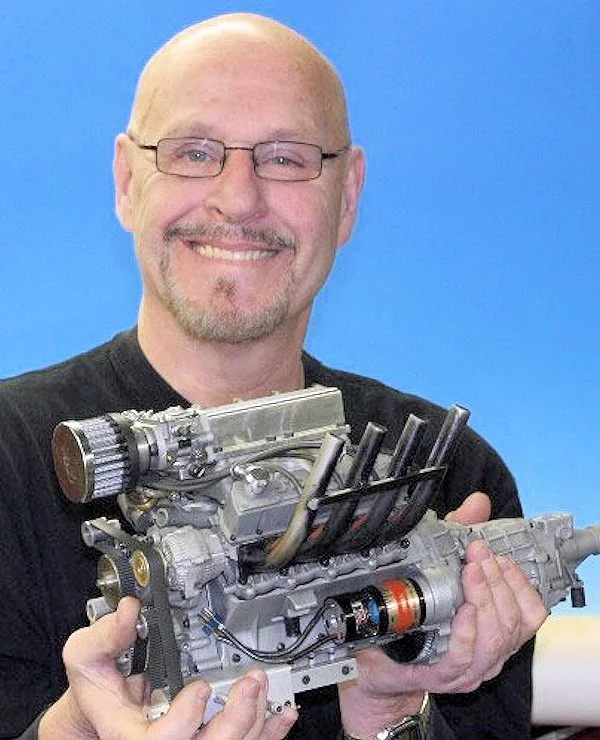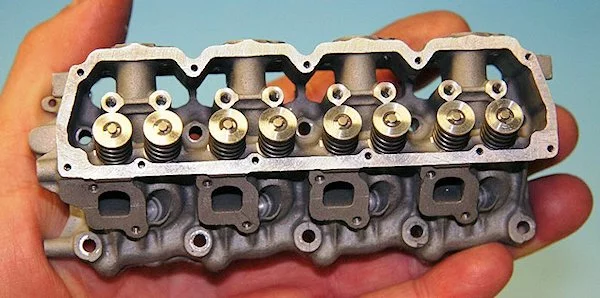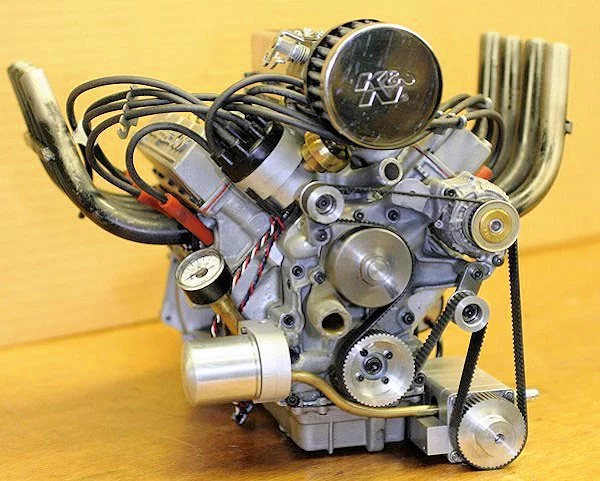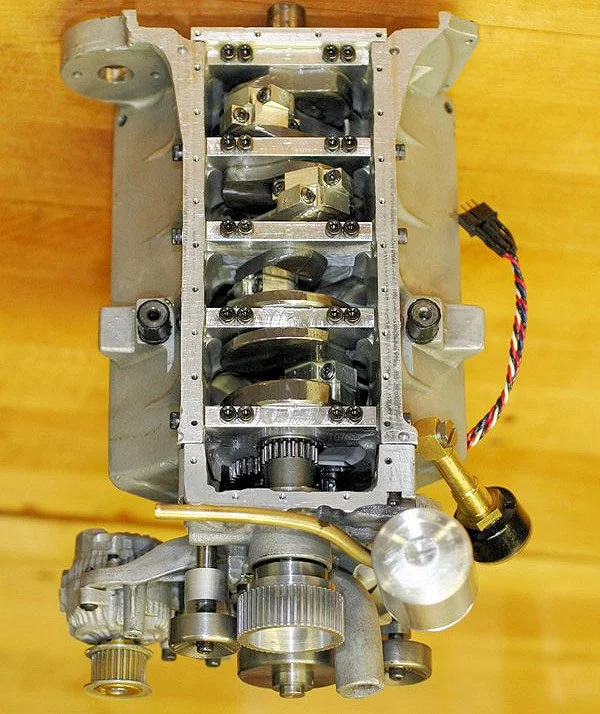Giant-scale model cars (and airplanes) powered by small gasoline engines have been popular with adult racers for quite a few years now. The largest scale models available through conventional RC hobby outlets are one-fifth or one-sixth scale, but the serious racers go quarter-scale. Now the smallest (quarter-scale) blown V8 gasoline engine in commercial production is being turned out by Conley Precision Engines to power.
A quarter-scale gasoline-powered car is about 1.2 m (4 feet) in length, weighs around 50 kg (110 lbs), and can top out at over 160 kph (100 mph). The engines for such large models are usually two-cycle engines not dissimilar from the engines that power weedwackers and leaf blowers, typically beginning at about 33 cc (2.0 cu. in.) displacement, providing 3 to 4 hp at 6-8000 rpm.
Even the larger engines for quarter scale models are simple and relatively inexpensive. For example, a 160 cc (10 cu. in.) displacement gasoline motor that provides 17 hp at 9000 rpm while weighing only 4 kg (8.8 lbs) is available for about US$1000. (I did say relatively inexpensive). This is plenty of power for any quarter-scale wheeled vehicle one might want to race.

Why then is the racing community reacting with crackling excitement over the Conley Stinger 609, a new quarter-scale V8 with supercharging, 100 cc (6.09 cu. in.) displacement, and a power output of 9.5 horsepower at 10,000 rpm – especially with a list price over US$7000? Simply enough, other engines don't look or sound right.
If you are going to spend a significant portion of a year's salary on a scale model car, expecting to own a true scale model isn't unreasonable. For example, the 1969 Dodge Charger Daytona, one of the quintessential Detroit muscle cars, was 5.75 m (18.9 ft.) long, weighed about 1690 kg (3730 lbs), and had a 7.0 l (426 cu in) hemi V8 that put out 425 hp. Scaling to one-quarter the size would give a model 1.44 m (4.7 ft) in length and weighing about 26 kg (57 lb). The scaled engine would have a displacement of 109 cc (6.6 cu in) with an output of 6.6 horsepower.
To some extent, the changes required to make a scale model look and perform in a properly scaled manner can be accomplished by changing the materials of which the model is constructed. For example, using strict scaling the loading on the tires on the pavement is considerably smaller for the scale model than for the original car. This makes for poorer handling and performance, as the power of the engine will cause the tires to break free, wasting power and losing traction in curves. It may be possible to save the performance and the appearance of the model, for example, by substituting a rubber for the tires that either has proportionally larger contact areas (a more compliant material) or a stickier rubber, or both. Such substitutions may allow a scale model to perform properly while keeping its scale appearance.

But a powered scale model of a car isn't just one with the right appearance, or even if properly scale performance is produced. A great deal of the enjoyment of racing is the sound of the car, and especially of the engine. Nothing else in the world quite sounds like a big block V8 turning over, then running up through the power curve. The rumble at low speeds is hypnotic, while the special screaming wail at high rpms adds greatly to the excitement of the race. In short, serious quarter-scale racers want their models to sound right, and this largely drives the demand for the Conley 609. It sounds like the real thing – only two octaves higher in pitch.

Of course, a scale-model engine also encounters difficulties associated with simple scaling. A particular problem comes from lubrication – it is very hard to adequately lubricate the cylinder and piston walls to survive running at 10,000 rpm. This problem was eventually solved with the help of manufacturing engineers from Sunnen Products Co., a leader in precision honing who worked with Conley to make the engine's cylinder liners. It proved necessary to deeply hone a cross-hatched pattern in the cylinder liners, and then to plateau hone the liners to remove any lips and edges protruding from the first set of patterns. The cylinder liners then had sufficient excess oil capacity to adjust to the movements of the piston, and were smooth enough to significantly reduce the effects of those movements by maintaining closer tolerances between the pistons and the cylinder liners. The production models can be run for long periods at high rpm without excessive heating or wear.
The Conley Stinger 609 V-8 has an electric starter and a centrifugal clutch as standard equipment, and is available with or without the supercharger. The list price of the Stinger 609 in its naturally aspirated form is US$5695, although lower prices are available from some suppliers. The supercharger allows the engine to produce about 60 percent more power for an additional cost of US$1700.

Giant-scale model car racing is a high-tech sport which can be approached without having to put a new mortgage on the house. It also doesn't require "hold harmless" clauses in life insurance policies against accidents during races. The practitioners are an enthusiastic, outgoing lot who truly enjoy their hobby. More power to them.
Source: Conley Precision Engines via Design News


















